黄淮地区稻茬小麦超高产群体特征研究
适合黄淮地区的小麦品种

适合黄淮地区的小麦品种1. 引言小麦是我国重要的粮食作物之一,也是黄淮地区主要的农作物之一。
选择适合黄淮地区的小麦品种对于提高产量、优化品质具有重要意义。
本文将从生长周期、抗逆性、产量和品质等方面,探讨适合黄淮地区种植的小麦品种。
2. 生长周期小麦的生长周期是选择适合黄淮地区小麦品种的重要考虑因素之一。
黄淮地区的气候特点是四季分明,夏季炎热潮湿,冬季寒冷干燥。
因此,适合种植的小麦品种应具有较短的生长周期,以适应这种气候条件。
2.1 早熟品种早熟品种是适合黄淮地区种植的一类小麦品种。
这些品种具有生长周期短、抗旱能力强的特点。
在黄淮地区,种植早熟品种可以在春季尽早播种,以避开夏季高温和潮湿的气候,提高小麦的产量和品质。
2.2 中熟品种中熟品种是适合黄淮地区种植的另一类小麦品种。
这些品种的生长周期适中,能够在黄淮地区的气候条件下正常生长。
中熟品种的种植时间相对较晚,可以避开夏季高温和潮湿的气候,降低小麦发生病虫害的风险。
3. 抗逆性黄淮地区的气候条件多变,存在着干旱、高温、寒冷等不利因素。
选择具有良好抗逆性的小麦品种,是确保黄淮地区小麦产量稳定的关键。
3.1 抗旱性抗旱性是选择适合黄淮地区种植的小麦品种的重要指标之一。
黄淮地区夏季气温高、降水少,干旱是影响小麦生长和产量的主要因素之一。
选择具有较强抗旱能力的小麦品种,可以降低干旱对小麦产量的影响。
3.2 抗寒性抗寒性是选择适合黄淮地区种植的小麦品种的另一个重要指标。
黄淮地区冬季气温较低,寒冷是影响小麦生长和越冬能力的关键因素。
选择具有较强抗寒能力的小麦品种,可以保证小麦在冬季正常生长,提高产量和品质。
4. 产量和品质选择适合黄淮地区种植的小麦品种,除了考虑生长周期和抗逆性外,还需要关注其产量和品质。
4.1 高产量品种高产量是选择适合黄淮地区种植的小麦品种的重要指标之一。
黄淮地区是我国重要的粮食生产区域,提高小麦的产量对于保障粮食供应具有重要意义。
选择高产量品种可以提高小麦的产量,增加农民的收益。
高产多抗国审小麦新品种—存麦633
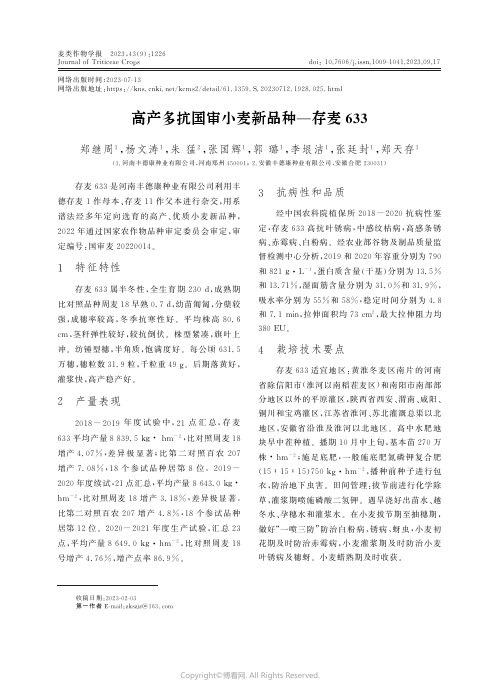
麦类作物学报 2023,43(9):1226J o u r n a l ofT r i t i c e a eC r o p s d o i :10.7606/j.i s s n .1009-1041.2023.09.17网络出版时间:2023-07-13网络出版地址:h t t ps ://k n s .c n k i .n e t /k c m s 2/d e t a i l /61.1359.S .20230712.1928.025.h t m l 高产多抗国审小麦新品种—存麦633收稿日期:2023-02-03第一作者E -m a i l :z k s z jz @163.c o m 郑继周1,杨文涛1,朱猛2,张国辉1,郭璐1,李垠洁1,张廷封1,郑天存1(1.河南丰德康种业有限公司,河南郑州450001;2.安徽丰德康种业有限公司,安徽合肥230031) 存麦633是河南丰德康种业有限公司利用丰德存麦1作母本㊁存麦11作父本进行杂交,用系谱法经多年定向选育的高产㊁优质小麦新品种,2022年通过国家农作物品种审定委员会审定,审定编号:国审麦20220014㊂1 特征特性存麦633属半冬性,全生育期230d,成熟期比对照品种周麦18早熟0.7d ,幼苗匍匐,分蘖较强,成穗率较高,冬季抗寒性好㊂平均株高80.6c m ,茎秆弹性较好,较抗倒伏㊂株型紧凑,旗叶上冲㊂纺锤型穗,半角质,饱满度好㊂每公顷631.5万穗,穗粒数31.9粒,千粒重49g㊂后期落黄好,灌浆快,高产稳产好㊂2 产量表现2018-2019年度试验中,21点汇总,存麦633平均产量8839.5k g ㊃h m -2,比对照周麦18增产4.07%,差异极显著;比第二对照百农207增产7.08%,18个参试品种居第8位㊂2019-2020年度续试,21点汇总,平均产量8643.0k g ㊃h m -2,比对照周麦18增产3.18%,差异极显著㊂比第二对照百农207增产4.8%,18个参试品种居第12位㊂2020-2021年度生产试验,汇总23点,平均产量8649.0k g ㊃h m -2,比对照周麦18号增产4.76%,增产点率86.9%㊂3 抗病性和品质经中国农科院植保所2018-2020抗病性鉴定,存麦633高抗叶锈病,中感纹枯病,高感条锈病㊁赤霉病㊁白粉病㊂经农业部谷物及制品质量监督检测中心分析,2019和2020年容重分别为790和821g ㊃L -1,蛋白质含量(干基)分别为13.5%和13.71%,湿面筋含量分别为31.0%和31.9%,吸水率分别为55%和58%,稳定时间分别为4.8和7.1m i n ,拉伸面积均73c m2,最大拉伸阻力均380E U ㊂4 栽培技术要点存麦633适宜地区:黄淮冬麦区南片的河南省除信阳市(淮河以南稻茬麦区)和南阳市南部部分地区以外的平原灌区,陕西省西安㊁渭南㊁咸阳㊁铜川和宝鸡灌区,江苏省淮河㊁苏北灌溉总渠以北地区,安徽省沿淮及淮河以北地区㊂高中水肥地块早中茬种植㊂播期10月中上旬,基本苗270万株㊃h m -2;施足底肥,一般施底肥氮磷钾复合肥(15ʒ15ʒ15)750k g ㊃h m -2,播种前种子进行包衣,防治地下虫害㊂田间管理:拔节前进行化学除草,灌浆期喷施磷酸二氢钾㊂遇旱浇好出苗水㊁越冬水㊁孕穗水和灌浆水㊂在小麦拔节期至抽穗期,做好 一喷三防 防治白粉病㊁锈病㊁蚜虫,小麦初花期及时防治赤霉病,小麦灌浆期及时防治小麦叶锈病及穗蚜㊂小麦蜡熟期及时收获㊂Copyright ©博看网. All Rights Reserved.。
(王延训)山农20小麦的生物学特性及其秸秆还田地块的高产稳产栽培
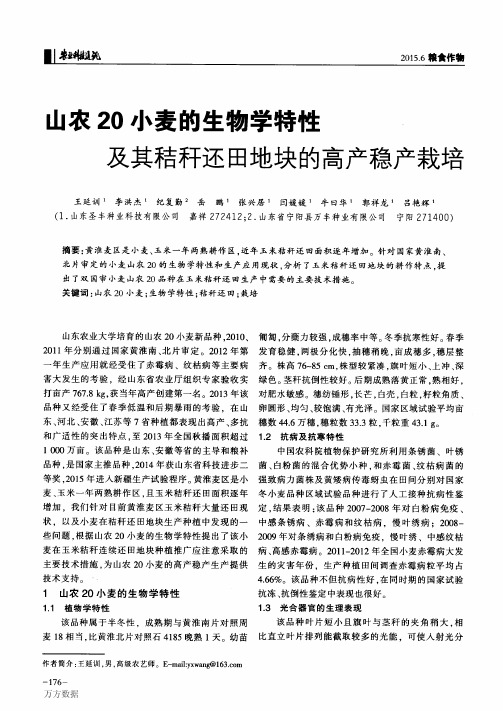
万方数据
万方数据
万方数据
山农20小麦的生物学特性及其秸秆还田地块的高产稳产栽培
作者:王延训, 李洪杰, 纪复勤, 岳鹏, 张兴居, 闫媛媛, 牛曰华, 郭祥龙, 吕艳辉
作者单位:王延训,李洪杰,岳鹏,张兴居,闫媛媛,牛曰华,郭祥龙,吕艳辉(山东圣丰种业科技有限公司 嘉祥272412), 纪复勤(山东省宁阳县万丰种业有限公司 宁阳271400)
刊名:
农业科技通讯
英文刊名:Bulletin of Agricultural Science and Technology
年,卷(期):2015(6)
引用本文格式:王延训.李洪杰.纪复勤.岳鹏.张兴居.闫媛媛.牛曰华.郭祥龙.吕艳辉山农20小麦的生物学特性及其秸秆还田地块的高产稳产栽培[期刊论文]-农业科技通讯 2015(6)。
淮北地区稻茬晚播小麦品种产量比较试验研究
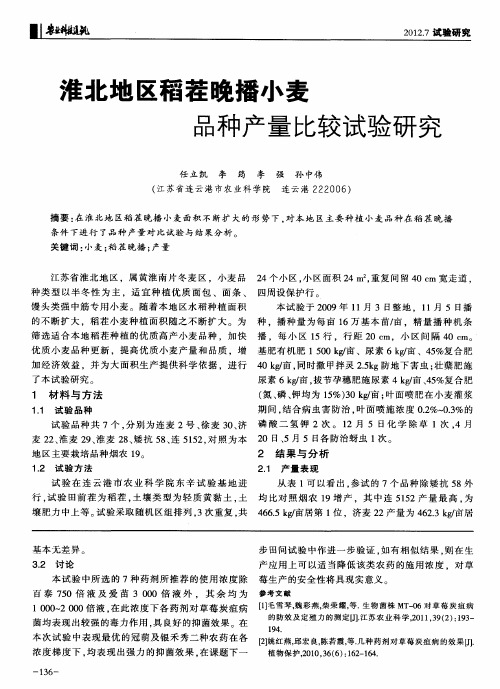
1 6 3 -
试 研 0. 验 究22 17
舭辞 桃 l I l 缸
第 2位 ,连 麦 2号 以 4 96k / 居第 3位 ,分别 比 且 当年赤 霉 病暴 发 .大量 的病 株病 粒显 著 影 响最 终 5 . g亩 C K增 产 64 54 48 达极 显 著水 平 。淮 麦 2 、 产 量 , 其 以矮 抗 5 . %、 .%、.%, 9 尤 8最 为严 重 , 麦 2号 、 麦 2 、 连 济 2 徐麦 3、 麦 2 0淮 8等 3个 品种 也 比 C K增 产 , 矮 抗 连 5 5 而 12病 害 较 轻 。气 候 对 植 株 性 状 的影 响 比较 明
1 材 料 与 方 法
11 试验 品种 .
2月 5 日化 学 除 草 1次 , 4月 试验 品种 共 7个 , 别 为 连 麦 2号 、 麦 3 、 分 徐 O 济 磷 酸 二 氢 钾 2次 。 1 0日、 5月 5日各 防 治蚜虫 1 。 次 麦 2、 2 淮麦 2 、 麦 2 、 抗 5 、 5 5 , 照 为 本 2 9淮 8矮
5 8亩产 3 29k . C 8 . g 比 K减 产 1 . 27 %。 22 特征 特 性 .
显 , 体表 现见 表 2 具 。
从 表 2中 可 以 看 出 。株 高 以 烟 农 1 9最 高 为
由于 2 1 0 1年气 候 特 殊 ,在 5 6月 份持 续 低 温 , 8 . e 矮 抗 5 、 81 m. 8最矮 为 7 . c 其 他 连麦 2号 、 3 m。 5 连
壤 肥力 中上 等 。 验采 取 随机 区组排 列 , 次 重 复 , 试 3 共 4 65k 6 . W亩居第 1 ,济 麦 2 量 为 4 23k 位 2产 6 . W亩居
黄淮冬麦区高产耐逆抗病新种质创制与应用
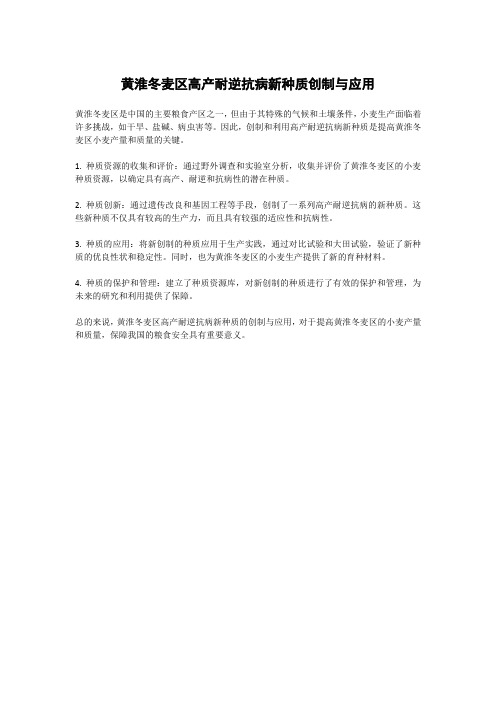
黄淮冬麦区高产耐逆抗病新种质创制与应用
黄淮冬麦区是中国的主要粮食产区之一,但由于其特殊的气候和土壤条件,小麦生产面临着许多挑战,如干旱、盐碱、病虫害等。
因此,创制和利用高产耐逆抗病新种质是提高黄淮冬麦区小麦产量和质量的关键。
1. 种质资源的收集和评价:通过野外调查和实验室分析,收集并评价了黄淮冬麦区的小麦种质资源,以确定具有高产、耐逆和抗病性的潜在种质。
2. 种质创新:通过遗传改良和基因工程等手段,创制了一系列高产耐逆抗病的新种质。
这些新种质不仅具有较高的生产力,而且具有较强的适应性和抗病性。
3. 种质的应用:将新创制的种质应用于生产实践,通过对比试验和大田试验,验证了新种质的优良性状和稳定性。
同时,也为黄淮冬麦区的小麦生产提供了新的育种材料。
4. 种质的保护和管理:建立了种质资源库,对新创制的种质进行了有效的保护和管理,为未来的研究和利用提供了保障。
总的来说,黄淮冬麦区高产耐逆抗病新种质的创制与应用,对于提高黄淮冬麦区的小麦产量和质量,保障我国的粮食安全具有重要意义。
稻茬小麦新品种淮麦33特征特性及超高产栽培技术
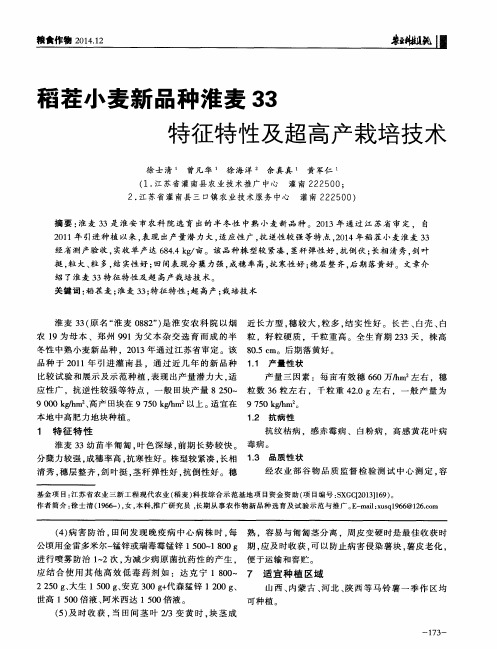
一
可种植ቤተ መጻሕፍቲ ባይዱ。
1 7 3—
舭枇挑
稳定 时 间 5 . 7 m i n 。
2 0 1 4 . 1 2 粮 食作物
定基本 苗 3 3 0万/ h m ,千 粒 重 4 1 g ,发 芽 率 8 0 %,
应 结 合 使 用 其 他 高 效 低 毒 药 剂 如 :达 克 宁 1 8 0 0 ~ 7 适 宜 种 植 区域 2 2 5 0 g 、 大生 1 5 0 0 g 、 安克 3 0 0 g + 代 森猛 锌 1 2 0 0 g 、 山西 、 内蒙古 、 河北 、 陕西 等 马铃 薯 一 季作 区 均
. 3 精 细播种 2 0 1 1 — 2 0 1 2年 连续 二 年 参 加 本 地 小 麦 新 品种 比 4
机械条播 , 完成旋耕 、 播种 、 覆土 、 机械 镇压等 ,
农 1 9为 母 本 、郑 州 9 9 1为 父 本 杂 交 选 育 而 成 的 半 粒 ,籽 粒 硬质 ,千 粒重 高 。全 生育 期 2 3 3天 ,株高
冬 性 中熟 小 麦新 品种 ,2 0 1 3年通 过 江苏 省 审定 。该 8 0 . 5 c m。后 期 落黄好 。 品种 于 2 0 1 1年 引 进 灌 南 县 .通 过 近 几 年 的新 品 种 1 . 1 产量 性状 比较 试 验 和展 示 及 示 范种 植 。 表 现 出产 量 潜 力 大 . 适 产 量 三 因素 :每 亩 有效 穗 6 6 0万/ h m 左 右 .穗 应 性 广 ,抗 逆性 较 强等 特 点 ,一 般 田块产 量 8 2 5 0 ~ 粒数 3 6粒 左 右 ,千 粒 重 4 2 . 0 g左 右 ,一 般 产 量 为
试论小麦品种淮麦25特征特性及高产栽培技术
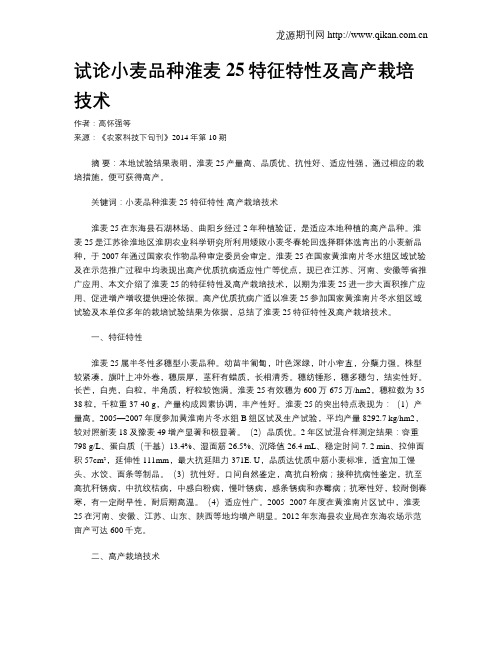
试论小麦品种淮麦25特征特性及高产栽培技术作者:高怀强等来源:《农家科技下旬刊》2014年第10期摘要:本地试验结果表明,淮麦25产量高、品质优、抗性好、适应性强,通过相应的栽培措施,便可获得高产。
关键词:小麦品种淮麦25 特征特性高产栽培技术淮麦25在东海县石湖林场、曲阳乡经过2年种植验证,是适应本地种植的高产品种。
淮麦25是江苏徐淮地区淮阴农业科学研究所利用矮败小麦冬春轮回选择群体选育出的小麦新品种,于2007年通过国家农作物品种审定委员会审定。
淮麦25在国家黄淮南片冬水组区域试验及在示范推广过程中均表现出高产优质抗病适应性广等优点,现已在江苏、河南、安徽等省推广应用、本文介绍了淮麦25的特征特性及高产栽培技术,以期为淮麦25进一步大面积推广应用、促进增产增收提供理论依据。
高产优质抗病广适以准麦25参加国家黄淮南片冬水组区域试验及本单位多年的栽培试验结果为依据,总结了淮麦25特征特性及高产栽培技术。
一、特征特性淮麦25属半冬性多穗型小麦品种。
幼苗半匍匐,叶色深绿,叶小窄直,分蘖力强。
株型较紧凑,旗叶上冲外卷,穗层厚,茎秆有蜡质,长相清秀。
穗纺锤形,穗多穗匀,结实性好。
长芒,白壳,白粒,半角质,籽粒较饱满。
淮麦25有效穗为600万-675万/hm2,穗粒数为35-38粒,千粒重37-40 g,产量构成因素协调,丰产性好。
淮麦25的突出特点表现为:(1)产量高。
2005—2007年度参加黄淮南片冬水组B组区试及生产试验,平均产量8292.7 kg/hm2,较对照新麦18及豫麦49增产显著和极显著。
(2)品质优。
2年区试混合样测定结果:容重798 g/L、蛋白质(干基)13.4%、湿面筋26.5%、沉降值26.4 mL、稳定时间7. 2 min、拉伸面积57cm²,延伸性111mm,最大抗延阻力371E. U,品质达优质中筋小麦标准,适宜加工馒头、水饺、面条等制品。
(3)抗性好。
口间自然鉴定,高抗白粉病;接种抗病性鉴定,抗至高抗秆锈病,中抗纹枯病,中感白粉病,慢叶锈病,感条锈病和赤霉病;抗寒性好,较耐倒春寒,有一定耐早性,耐后期高温。
沿淮、江淮地区麦稻周年平衡增产技术集成研究与示范

交 中 稻 亩产 70公 斤 栽 培 技 术 规 程 ” 滁 州 市 0 ( 准 , B 4 lT 1 — 0 9 , 江淮地 区麦稻周 年 平 D 3 1 /0 4 2 0 ) “
沿 淮 江 淮 地 区麦 稻 周 年 平 衡 增 产 技 术 集 威 示 范 的 主 要 进 展 和成 果 包 括 如 下 几 个 方 面 。
率达 到 9 %以上 , 丰工 程 项 目区 达 到 10 龙 亢 农 5 粮 0 %。 场 筛 选 出 小 麦 “ 麦 96 、 偃 展 4 l” “ 福 麦 1 阜 3” “ 1O 、 新
号 ” “ 麦 5号 ” “ 麦 9号 ” 等 品 种 ,水 稻 “ 协 1 、泛 、濮 天
相应 调 整播 量 ( 每提 前 3天 , 量 减 05公 斤 , 播 . 每推 迟 3 天 ,播 量加 05 斤 ) “ 沟 ”配 套 ,田外 加一 条丰 产 .公 ;三
质 品种筛 选 与展示 、氮钾 肥施 用量 及不 同叶龄追 施氮 肥 对水稻 群体 质量 和产量 的影 响 、稻茬 麦配 套栽 培技 术、 稻茬 麦少免 耕秸秆 覆盖 技术 、 产条 件下 麦稻 两熟 高 养分 调控 与土壤 养分 平衡 技术 、稻 麦重 大病 虫害 防控
技 术 、 麦 “4 4 肥 效 试 验 等 l 项 试 验 研 究 。 亢 稻 31” 0多 龙
( 州 市 地 方 标 准 , B 4 1 0 3 2 0 ) “ 淮 滁 D 3 1/ 1 — 0 7 , 江 T
开展技术 集成研 究 与示 范 。凤 台县开 展 了麦 稻 高产优 合生 产技 术与单 项技 术规 程 .初步 形成 了沿
农场 连续 开展 了小麦 与水 稻新 品种 筛选 、晚播 小 麦配
其周边 地 区推 广应 用 。 台县地 处 沿淮 中部 , 生产 粳 凤 有
淮麦33小麦高产栽培技术
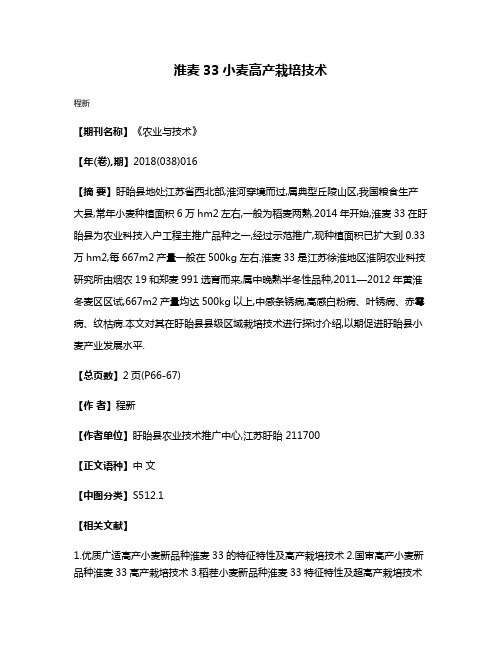
淮麦33小麦高产栽培技术
程新
【期刊名称】《农业与技术》
【年(卷),期】2018(038)016
【摘要】盱眙县地处江苏省西北部,淮河穿境而过,属典型丘陵山区,我国粮食生产大县,常年小麦种植面积6万hm2左右,一般为稻麦两熟.2014年开始,淮麦33在盱眙县为农业科技入户工程主推广品种之一,经过示范推广,现种植面积已扩大到0.33万hm2,每667m2产量一般在500kg左右.淮麦33是江苏徐淮地区淮阴农业科技研究所由烟农19和郑麦991选育而来,属中晚熟半冬性品种,2011—2012年黄淮冬麦区区试,667m2产量均达500kg以上,中感条锈病,高感白粉病、叶锈病、赤霉病、纹枯病.本文对其在盱眙县县级区域栽培技术进行探讨介绍,以期促进盱眙县小麦产业发展水平.
【总页数】2页(P66-67)
【作者】程新
【作者单位】盱眙县农业技术推广中心,江苏盱眙 211700
【正文语种】中文
【中图分类】S512.1
【相关文献】
1.优质广适高产小麦新品种淮麦33的特征特性及高产栽培技术
2.国审高产小麦新品种淮麦33高产栽培技术
3.稻茬小麦新品种淮麦33特征特性及超高产栽培技术
4.小麦新品种淮麦33特征特性及高产栽培技术
5.淮麦33小麦的特征特性及高产栽培技术
因版权原因,仅展示原文概要,查看原文内容请购买。
小麦新品种濉1309及高产栽培技术
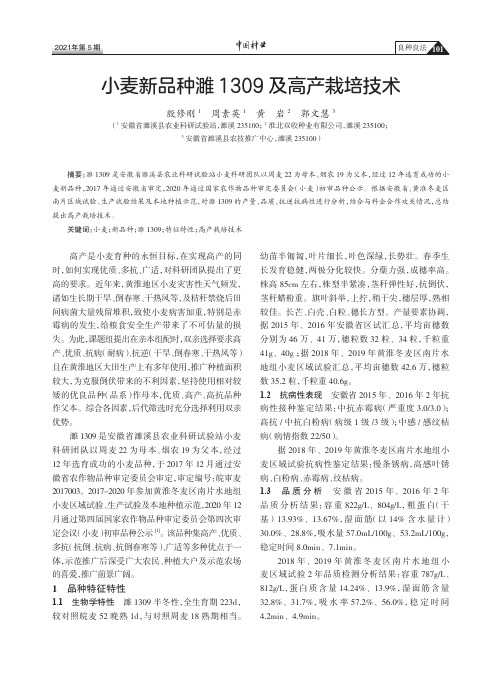
小麦新品种濉1309及高产栽培技术殷修刚1 周素英1 黄 岩2 郭文慧3(1安徽省濉溪县农业科研试验站,濉溪235100;2淮北双收种业有限公司,濉溪235100;3安徽省濉溪县农技推广中心,濉溪235100)摘要:濉1309是安徽省濉溪县农业科研试验站小麦科研团队以周麦22为母本、烟农19为父本,经过12年选育成功的小麦新品种,2017年通过安徽省审定,2020年通过国家农作物品种审定委员会(小麦)初审品种公示。
根据安徽省、黄淮冬麦区南片区域试验、生产试验结果及本地种植示范,对濉1309的产量、品质、抗逆抗病性进行分析,结合与科企合作攻关情况,总结提出高产栽培技术。
关键词:小麦;新品种;濉1309;特征特性;高产栽培技术高产是小麦育种的永恒目标,在实现高产的同时,如何实现优质、多抗、广适,对科研团队提出了更高的要求。
近年来,黄淮地区小麦灾害性天气频发,诸如生长期干旱、倒春寒、干热风等,及秸秆禁烧后田间病菌大量残留堆积,致使小麦病害加重,特别是赤霉病的发生,给粮食安全生产带来了不可估量的损失。
为此,课题组提出在亲本组配时,双亲选择要求高产、优质、抗病(耐病)、抗逆(干旱、倒春寒、干热风等)且在黄淮地区大田生产上有多年使用,推广种植面积较大,为克服倒伏带来的不利因素,坚持使用相对较矮的优良品种(品系)作母本,优质、高产、高抗品种作父本。
综合各因素,后代筛选时充分选择利用双亲优势。
濉1309是安徽省濉溪县农业科研试验站小麦科研团队以周麦22为母本、烟农19为父本,经过12年选育成功的小麦品种,于2017年12月通过安徽省农作物品种审定委员会审定,审定编号:皖审麦2017003。
2017-2020年参加黄淮冬麦区南片水地组小麦区域试验、生产试验及本地种植示范,2020年12月通过第四届国家农作物品种审定委员会第四次审定会议(小麦)初审品种公示[1]。
该品种集高产、优质、多抗(抗倒、抗病、抗倒春寒等)、广适等多种优点于一体,示范推广后深受广大农民、种植大户及示范农场的喜爱,推广前景广阔。
灌云县迟播稻茬小麦高产栽培技术

灌云县迟播稻茬小麦高产栽培技术1. 引言1.1 灌云县迟播稻茬小麦高产栽培技术概述灌云县迟播稻茬小麦高产栽培技术是指在灌云县地区栽培小麦时,采取迟播和利用前茬稻田的种植技术,以提高小麦的产量和质量。
迟播稻茬小麦高产栽培技术是在充分利用前茬稻田的基础上,通过科学种植和管理,实现了小麦的高产。
灌云县地处黄淮海平原,土质肥沃,气候适宜,适宜发展迟播稻茬小麦高产栽培技术。
该技术不仅可以有效利用土壤养分和水源,还可以减少对化肥和农药的使用。
通过科学施肥、合理田间管理和采用先进农机具等措施,可以提高小麦的产量和品质,增加农民收入,促进农业的可持续发展。
迟播稻茬小麦高产栽培技术的推广和应用对于提升农业生产水平,改善农民生活水平,推动灌云县农业经济的发展具有重要意义。
2. 正文2.1 迟播稻茬小麦高产栽培技术原理迟播稻茬小麦高产栽培技术的原理是利用稻田余热和水分充足的条件,利用农田的养分和土壤的温度,有针对性地选择适宜的时间和方式进行小麦的种植。
迟播稻茬小麦高产栽培技术的核心理念是利用水稻割茬后土壤残留的肥料和养分,通过适当的施肥和管理手段调节土壤的生态环境,为小麦生长提供有力的支持。
迟播稻茬小麦技术还可以有效减少土壤病虫害的发生,提高土壤养分的利用率,最大限度地增加小麦的产量和质量。
通过合理安排小麦的生长期和水稻的周期,迟播稻茬小麦高产栽培技术不仅能够提高农田的经济效益,还可以促进农业的可持续发展,为农民带来更丰厚的经济收益。
2.2 选用适宜品种选用适宜品种是灌云县迟播稻茬小麦高产栽培技术中非常重要的一环。
选择适宜的品种可以有效提高小麦的产量和质量,提高农民的经济收益。
在灌云县的实际种植过程中,根据当地的气候条件、土壤特点和生长环境等因素,选择适宜的小麦品种至关重要。
选择适宜品种要考虑该品种对当地气候条件的适应性。
灌云县属于温带季风气候,具有夏季炎热、冬季寒冷的气候特点。
选择早熟抗旱耐寒的小麦品种是非常关键的。
淮麦29的特征特性及高产栽培技术
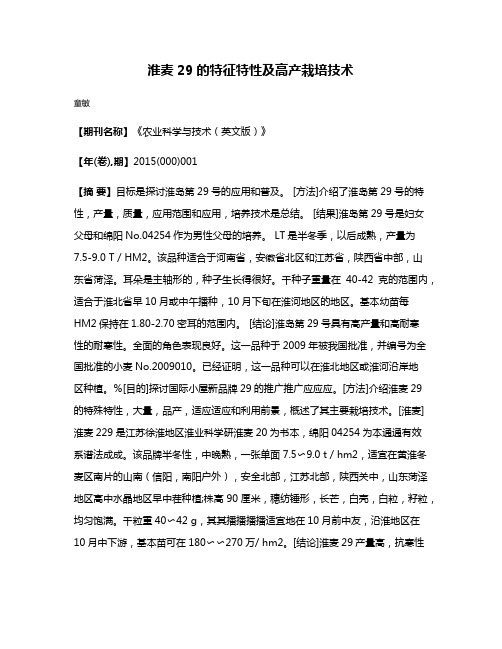
淮麦29的特征特性及高产栽培技术童敏【期刊名称】《农业科学与技术(英文版)》【年(卷),期】2015(000)001【摘要】目标是探讨淮岛第29号的应用和普及。
[方法]介绍了淮岛第29号的特性,产量,质量,应用范围和应用,培养技术是总结。
[结果]淮岛第29号是妇女父母和绵阳No.04254作为男性父母的培养。
LT是半冬季,以后成熟,产量为7.5-9.0 T / HM2。
该品种适合于河南省,安徽省北区和江苏省,陕西省中部,山东省菏泽。
耳朵是主轴形的,种子生长得很好。
千种子重量在40-42克的范围内,适合于淮北省早10月或中午播种,10月下旬在淮河地区的地区。
基本幼苗每HM2保持在1.80-2.70密耳的范围内。
[结论]淮岛第29号具有高产量和高耐寒性的耐寒性。
全面的角色表现良好。
这一品种于2009年被我国批准,并编号为全国批准的小麦No.2009010。
已经证明,这一品种可以在淮北地区或淮河沿岸地区种植。
%[目的]探讨国际小屋新品牌29的推广推广应应应。
[方法]介绍淮麦29的特殊特性,大量,品产,适应适应和利用前景,概述了其主要栽培技术。
[淮麦]淮麦229是江苏徐淮地区淮业科学研淮麦20为书本,绵阳04254为本通通有效系谱法成成。
该品牌半冬性,中晚熟,一张单面7.5〜9.0 t / hm2,适宜在黄淮冬麦区南片的山南(信阳,南阳户外),安全北部,江苏北部,陕西关中,山东菏泽地区高中水晶地区早中茬种植;株高90厘米,穗纺锤形,长芒,白壳,白粒,籽粒,均匀饱满。
千粒重40〜42 g,其其播播播播适宜地在10月前中友,沿淮地区在10月中下游,基本苗可在180〜〜270万/ hm2。
[结论]淮麦29产量高,抗寒性强,复合性好,该该于于2009年通讯国家审定,审定议号为国际2009010.若要多年试验,在安防淮北旱茬麦和沿淮地区的稻茬麦区可种植。
【总页数】4页(P31-34)【作者】童敏【作者单位】安徽皖垦种业股份有限公司,安徽合肥 230061【正文语种】中文因版权原因,仅展示原文概要,查看原文内容请购买。
浅谈影响淮阴地区稻茬麦高产的原因及对策
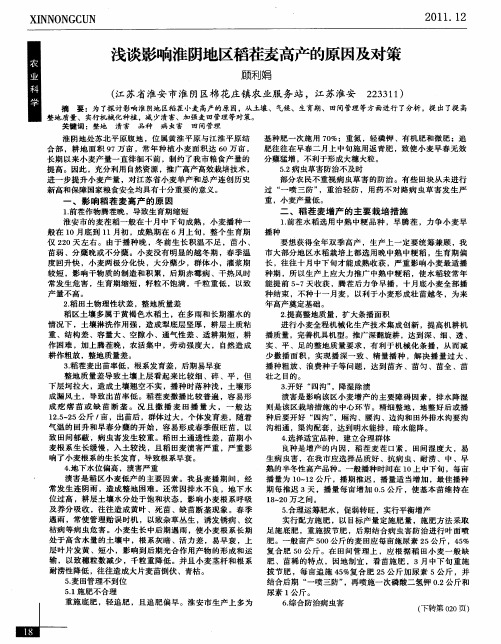
2提高整 地质 量 ,扩 大条播 面积 . 进行 小麦 全程 机械 化 生产 技 术集 成 创新 ,提 高 机耕 机 播 质量 ,完善机 具机型 。推 广深翻旋 耕 , 到 深 、细 、透 、 达 实 、平 、足的 整地 质量 要求 ,有 利 于机 械化 条 播 ,从 而减 少撒 播 面 积 ,实 现播 深 一致 、精 量播 种 ,解 决播 量 过 大 、 播 种 粗放 、浪 费种 子 等问题 ,达到 苗 齐 、苗 匀 、苗全 、苗
2稻 田土物理 性状 差 ,整 地质 量差 .
要 想获 得全 年双 季 高产 ,生产 上一 定 要统 筹 兼顾 ,我 市 大部分 地 区水 稻栽培 上 都选 用 晚 中熟 中粳稻 ,生育 期 偏 长 ,往往 十 月 中下旬 才能 成熟 收 获 ,严 重 影 响小 麦最 适播 种期 ,所 以生产 上应 大力 推广 中熟 中粳稻 ,使 水 稻较 常 年 能提 前 5 7天 收获 ,腾 茬 后力 争早 播 ,十 月底小 麦全 部 播 —
适合在黄淮种植的小麦品种
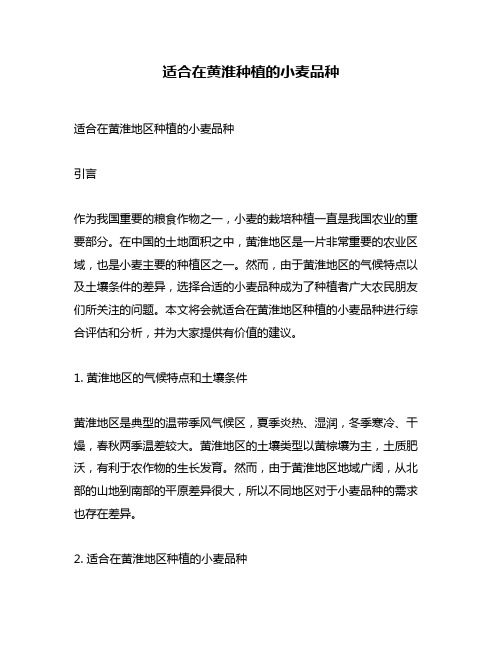
适合在黄淮种植的小麦品种适合在黄淮地区种植的小麦品种引言作为我国重要的粮食作物之一,小麦的栽培种植一直是我国农业的重要部分。
在中国的土地面积之中,黄淮地区是一片非常重要的农业区域,也是小麦主要的种植区之一。
然而,由于黄淮地区的气候特点以及土壤条件的差异,选择合适的小麦品种成为了种植者广大农民朋友们所关注的问题。
本文将会就适合在黄淮地区种植的小麦品种进行综合评估和分析,并为大家提供有价值的建议。
1. 黄淮地区的气候特点和土壤条件黄淮地区是典型的温带季风气候区,夏季炎热、湿润,冬季寒冷、干燥,春秋两季温差较大。
黄淮地区的土壤类型以黄棕壤为主,土质肥沃,有利于农作物的生长发育。
然而,由于黄淮地区地域广阔,从北部的山地到南部的平原差异很大,所以不同地区对于小麦品种的需求也存在差异。
2. 适合在黄淮地区种植的小麦品种2.1 气候适应性强的小麦品种由于黄淮地区的气候条件存在夏季炎热、冬季寒冷的特点,选择既耐寒又耐热的小麦品种非常重要。
在这方面,像是冀麦19号、冀麦24号、郑麦366、郑麦815等小麦品种具有很好的气候适应性,在黄淮地区具有广泛的种植应用。
2.2 抗性好的小麦品种黄淮地区的病虫害比较严重,选择具有较强抗病虫害的小麦品种对于提高产量、减少农药的使用具有重要意义。
在这方面,像是````登录或注册````杨麦22、郑麦978、亳麦935等小麦品种具有一定的抗性,可以有效地抵抗或减轻病虫害对农作物的危害。
2.3 时期适应性强的小麦品种由于黄淮地区春秋两季的气温、降水等因素具有较大的变化,选择具有时期适应性强的小麦品种对于稳定产量、降低风险非常重要。
在这方面,像是皖麦160、皖麦201、亳麦576等小麦品种,对于黄淮地区不同的种植季节有很好的适应性。
结论在黄淮地区种植小麦时,需要考虑气候特点、土壤条件以及各种品种的特性。
综合考虑的话,可以选择既耐寒又耐热、抗病虫害能力较强以及具有时期适应性强的小麦品种。
江苏淮南麦区近17年小麦品种产量性状及聚类分析
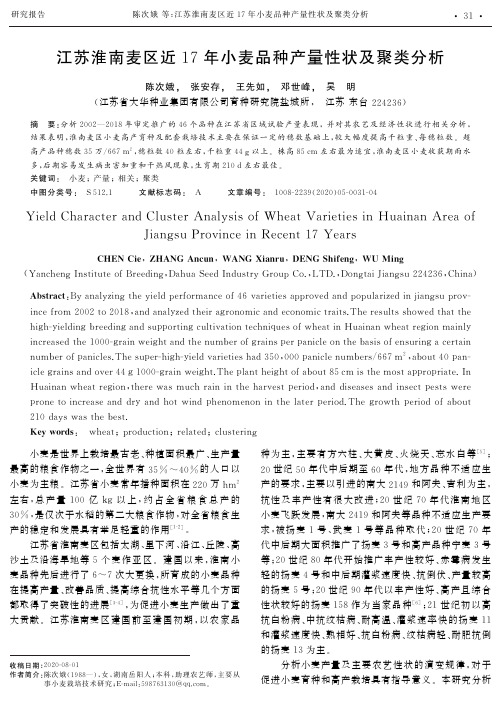
,为促进小麦生产做出了重
性状较好的扬麦 158 作为 当 家 品 种 [6];
21 世 纪 初 以 高
在提高产量、改善品质、提高综合抗性水平等几个方面
都取得了突破性的进展
[
3
4]
大贡献。江苏淮南麦 区 建 国 前 至 建 国 初 期,以 农 家 品
t17Ye
a
r
s
CHENC
i
e,ZHANGAnc
un,WANGXi
anr
u,DENGSh
i
f
e
ng,WU Mi
ng
(
,
,
YanchengI
ns
t
i
t
u
t
eo
fBr
e
ed
i
ng,
DahuaSe
edI
ndus
t
r
oupCo.
LTD.
Dong
t
a
iJ
i
angsu224236,
Ch
i
na)
yGr
Ab
s
t
r
a
沙土及沿海旱地等 5 个 麦 作 亚 区。 建 国 以 来,淮 南 小
种为主,主 要 有 方 六 柱、大 黄 皮、火 烧 天、忘 水 白 等 [5];
20 世纪 50 年代中后期至 60 年代,地 方 品 种 不 适 应 生
产的要求,主要以引进的南大 2149 和阿夫、吉利为主,
抗性 及 丰 产 性 有 很 大 改 进;
c
t:
Byana
lzingt来自heyie
l
dpe
r
国审小麦品种天民198特征特性及超高产栽培技术

国审小麦品种天民198特征特性及超高产栽培技术邱喜阳;王彦丽;邱海军;任秋芳;罗明;沈天民【摘要】国审天民198是由河南天民种业有限公司小麦育种所采用复合杂交、历经多代单株选择培育而成,亲本组合R81/百农64//偃展4110。
该品种属弱春性、多穗兼中大穗型中早熟类型,生育期218 d,株高约70 cm,抗倒、广适。
在2013—2014年度黄淮冬麦区南片春水组生产试验中,平均产量8080.5 kg/hm2,比对照增产5.52%,于2014年通过国家审定。
经多年生产示范集成了一套单产10500kg/hm2优质、高产、高效栽培技术规程。
%Tianmin 198 ( parental combination R81/Bainong 64//Yanzhan 4110 ) was bred by Henan Tianmin Seeds Limited Company through by composite hybridization and individual plant selection of mu-ti-generation. It is a weak springtype,muti-large spike and mid-early maturing variety,which height was 70 cm,growth period was 218 d,and had lodging resistance and wide adaptability. In 2013—2014,the av-erage yield in Huang-Huai spring group southern winter wheat region production test reached 8 080. 5 kg/ha, which increased by 5. 52% compared with the control. It was registered and released by the National Crop Variety Approval Committee in 2014. The system of super-high-yield with high quality, high efficiency cultivation technologies for Tianmin 198 was raised with yield of 10 500 kg/ha.【期刊名称】《河南农业科学》【年(卷),期】2015(000)012【总页数】3页(P39-41)【关键词】小麦;天民198;特征特性;超高产;栽培技术【作者】邱喜阳;王彦丽;邱海军;任秋芳;罗明;沈天民【作者单位】河南天民种业有限公司,河南兰考475300;河南天民种业有限公司,河南兰考475300;河南天民种业有限公司,河南兰考475300;河南天民种业有限公司,河南兰考475300;河南天民种业有限公司,河南兰考475300;河南天民种业有限公司,河南兰考475300【正文语种】中文【中图分类】S512.1天民198是由河南天民种业有限公司小麦育种所培育出的弱春性、多穗兼中大穗型中早熟品种,于2014年通过国家品种委员会审定。
稻–麦轮作下9000 kg hm–2产量水平扬麦20的群体质量及花后光合特征
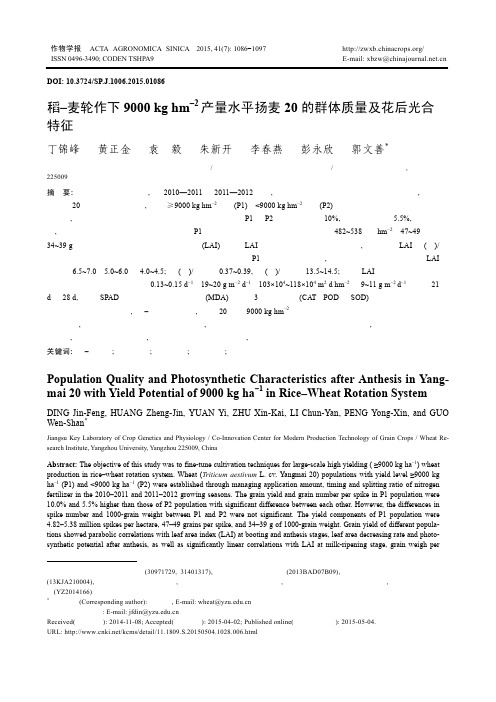
- 1、下载文档前请自行甄别文档内容的完整性,平台不提供额外的编辑、内容补充、找答案等附加服务。
- 2、"仅部分预览"的文档,不可在线预览部分如存在完整性等问题,可反馈申请退款(可完整预览的文档不适用该条件!)。
- 3、如文档侵犯您的权益,请联系客服反馈,我们会尽快为您处理(人工客服工作时间:9:00-18:30)。
Abstract
Studies on population characteristics of super-high-yielding wheat have recently attracted significant researches. These
studies have revealed large differences in wheat population structure in different super-high-yielding wheat areas. The area of wheat under rice stubble in the Huanghuai region has reached 1.3 million hm2, accounting for about 10% of cultivated wheat area in the Huanghuai region. Significant differences have been noted in the growth characteristics and ecological environments between dryland wheat and wheat under rice stubble. Current studies on population characteristics of wheat under rice stubble have focused mainly on production levels of 8 000 kg·hm2. Super-high-yielding wheat (yield is higher than 9 000 kg·hm2) was still in the infancy development stage, and studies on population characteristics of super-high-yielding wheat under rice stubble in Huanghuai area were less to be reported. To understand the population characteristics of super-high-yielding wheat-after-rice system in Huanghuai region, growth and yield formations of three semi-winter wheat varieties (‘Lianma 6’, ‘Jimai 22’ and ‘Yannong 19’) were investigated under high-yield (CK) and super-high-yield (SHY) cultivation measures. The results showed that wheat varieties had more grains per spike and higher 1000-grain weight under SHY than under high-yield wheat CK. There was no significant difference in spike number per
Population characteristics of super-high-yielding wheat under rice stubble in Huanghuai area
LU Baiguan1, DU Yong2, LI Jun2, WANG Baoxiang1, ZHOU Zhenling1, SUN Zhongwei1, YANG Bo1, QIN Derong1, XU Dayong1
[2]
张法全等 [6]认为 , 单产 10 000 kg·hm−2 小麦具有较高 的植株氮素积累量、 籽粒氮素积累量和花后营养器官 氮素向籽粒的转运量。 于振文等[11]认为, 高产(6 000~ 7 500 kg·hm−2)向超高产 (籽粒产量 >9 000 kg·hm−2)发 展的限制因素是小麦开花期至成熟期干物质积累和 分配与植株后期早衰的矛盾 , 超高产小麦每公顷吸 收氮的总量高于高产麦田, 但生产 100 kg 籽粒所需 的氮少于高产麦田, 应按照小麦需肥规律追肥[12−15]。 近年 , 黄淮地区直播稻面积不断扩大 , 水稻收 获期推迟 , 导致稻茬小麦播种期相应延时 [16], 稻茬 小麦与旱地小麦的生育特性存在较大差别 , 且稻茬 小麦和旱地小麦生长的生态环境也存在较大的差 别。因此 , 稻茬麦区在强调稻麦均衡增产的情况下 , 稻茬小麦的栽培技术与旱地小麦也应有一定的差别 , 而要制定出适合稻茬小麦的高产配套栽培技术 , 必 须 首 先 研 究 清 楚 稻 茬 小 麦 高 产 、 超 高 产 的 群 体特 征。由于稻茬麦区特殊的生态特点和品种的生育特 性 , 目前 , 关于稻茬小麦群体特征的研究主要集中 于 8 000 kg·hm−2 产量水平 [5,17], 对籽粒产量高于 9 000 kg·hm−2 的超高产群体特征和生理特性研究尚处 于起步阶段 , 少见关于稻茬小麦产量 >9 000 kg·hm−2 群体特征研究报道 [18]。 2009—2012 年我们承担了江苏省科技厅粮食丰 产工程 “稻麦周年优质高产新技术集成创新与示范 ” 项目 , 2010—2012 年进行稻麦超高产栽培试验 , 在 水稻实现 10 500 kg·hm−2 的基础上 , 稻茬小麦实现了 9 000 kg·hm−2 以上的产量, 全年实现了 19 500 kg·hm−2 的超高产目标。本研究以江苏淮北地区大面积推广 的具有超高产潜力的半冬性小麦品种 ‘连麦 6 号 ’、 ‘济麦 22’和‘烟农 19’为材料, 通过基本苗和氮素处理 (使用量、使用时期、比例 )及氮磷钾配比 , 建立不同 产量水平群体, 通过分析高产(7 380~7 889 kg·hm−2)、 超高产 (>9 000 kg·hm−2)两类群体产量构成因素 , 不
连云港 2. 连云港市农业技术推广中心 连云港 222001)
孙中伟 1
222006;
(1. 徐淮地区连云港农业科学研究所 /连云港市农业科学院
摘
要
为探讨黄淮地区稻茬小麦超高产 (>9 000 kg·hm−2)群体的生长发育特性 , 以该区域推广面积较大的半
冬性小麦品种 ‘连麦 6 号 ’、‘济麦 22’和 ‘烟农 19’为材料 , 在试验总结出包括基本苗调控和氮肥运筹等一套适宜 黄淮地区稻茬麦超高产栽培技术的基础上 , 建立稻茬小麦高产和超高产群体 , 对其系列生育、 生理特性以及产 量要素进行调查分析。结果表明 , 与高产小麦群体 (产量为 7 380~7 889 kg·hm−2)相比 , 超高产 (>9 000 kg·hm−2) 小麦群体单位面积穗数差异不显著 , 但穗粒数和千粒重显著增加 ; 超高产小麦抽穗前茎蘖数较高产群体少 , 但分蘖成穗率较高 ; 超高产群体小麦的叶面积指数 , 生育前期较高产群体低 , 抽穗后则显著高于高产群体 , 两 者干物质积累生育前期无明显差异 ; 超高产小麦抽穗期、乳熟期与蜡熟期的根冠比、根系伤流量均显著高于高 产群体; 超高产小麦粒叶比、茎鞘物质运转率和收获指数均高于高产群体。因此, 本文提出了黄淮地区稻茬小麦 超高产(>9 000 kg·hm−2)群体的产量结构与群体指标: 单位面积穗数(700±20)×104·hm−2, 每穗实粒数>32, 千粒重 >42 g, 茎蘖成穗率>45%; 抽穗期叶面积指数 6.5~7.0; 成熟期总干重>20 700 kg·hm−2, 粒叶比>14 mg·cm−2; 抽穗 期根冠比 >0.28, 根系伤流量 >7.1 g·m−2·h−1; 收获指数 >0.45。 关键词 黄淮地区 稻茬小麦 超高产栽培 群体特征 产量 中图分类号 : S512.1+1 文献标识码 : A 文章编号 : 1671-3990(2015)01-0043-09
44
中国生态农业学报 2015
第 23 卷
unit area between SHY and CK. Compared with those under CK, wheat exhibited fewer tillers at the early growth stage (from tillering to jointing) but with higher rate of productive tillers to total tillers under SHY. While leaf area index and photosynthetic potential of SHY were lower than those of CK at the early growth stage, these attributes were significantly higher after heading. There was no significant difference in accumulated dry matter weight between SHY and CK at the early growth stage. Root-to-shoot ratio and root exudate amount under SHY were higher than those under CK at heading, milking and waxing stages. Also grain-to-leaf ratio, percent matter translocation from stem and sheath, and harvest index under SHY were higher than those under CK. Analysis of various attributes of rice yield and population showed that for SHY wheat in Huanghuai region, spikes per unit area, grains per spike, 1000-grain weight, productive tiller rate, total dry matter weight at maturity stage, grain weight/leaf area ratio, root/shoot ratio at heading stage, root exudate amount, harvest index were greater than 700×104·hm2, 32, 42 g, 45%, 20 t·hm2, 14 g·cm2 (i.e., mg grain weight per cm2 leaf area), 0.28, 7.1 g·m2·h1, 0.45, respectively; while leaf area index at heading stage was 6.57.0. Keywords Huanghuai region; Wheat under rice stubble; Super-high-yielding cultivation; Population characteristics; Yield (Received Feb. 20, 2014; accepted Sep. 18, 2014)
